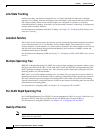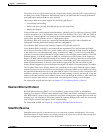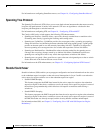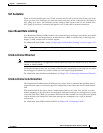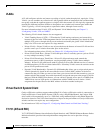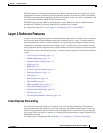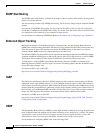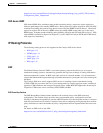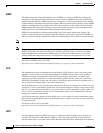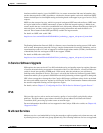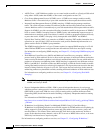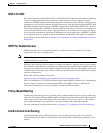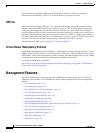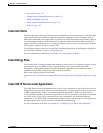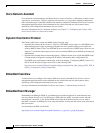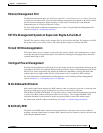
1-14
Software Configuration Guide—Release 15.0(2)SG
OL-23818-01
Chapter 1 Product Overview
Layer 3 Software Features
EIGRP
The Enhanced Interior Gateway Routing Protocol (EIGRP) is a version of IGRP that combines the
advantages of link-state protocols with distance-vector protocols. EIGRP incorporates the Diffusing
Update Algorithm (DUAL). EIGRP includes fast convergence, variable-length subnet masks, partially
bounded updates, and multiple network-layer support. When a network topology change occurs, EIGRP
checks its topology table for a suitable new route to the destination. If such a route exists in the table,
EIGRP updates the routing table instantly. You can use the fast convergence and partial updates that
EIGRP provides to route Internetwork Packet Exchange (IPX) packets.
EIGRP saves bandwidth by sending routing updates only when routing information changes. The
updates contain information only about the link that changed, not the entire routing table. EIGRP also
takes into consideration the available bandwidth when determining the rate at which it transmits updates.
Note Layer 3 switching does not support the Next Hop Resolution Protocol (NHRP).
Note Customers can configure Enhanced Interior Gateway Routing Protocol (EIGRP) to route IPv6 prefixes.
EIGRP configuration and protocol behavior for both IPv4 and IPv6 prefixes are similar, providing
operational familiarity and continuity. EIGRP support for IPv6 will enable customers to use their
existing EIGRP knowledge and processes, allowing them to deploy an IPv6 network at a low cost.
For details on EIGRP, refer to this URL:
http://www.cisco.com/en/US/products/ps6630/products_ios_protocol_option_home.html
IS-IS
The Intermediate System-to-Intermediate System Protocol (IS-IS Protocol) uses a link-state routing
algorithm. It closely follows the Open Shortest Path First (OSPF) routing protocol used within the
TCP/IP environment. The operation of ISO IS-IS Protocol requires each router to maintain a full
topology map of the network (that is, which intermediate systems and end systems are connected to
which other intermediate systems and end systems). Periodically, the router runs an algorithm over its
map to calculate the shortest path to all possible destinations.
The IS-IS Protocol uses a two-level hierarchy. Intermediate Systems (or routers) are classified as Level
1 and Level 2. Level 1 intermediate systems deal with a single routing area. Traffic is relayed only within
that area. Any other internetwork traffic is sent to the nearest Level 2 intermediate systems, which also
acts as a Level 1 intermediate systems. Level 2 intermediate systems move traffic between different
routing areas within the same domain.
An IS-IS with multi-area support allows multiple Level 1 areas within in a single intermediate system,
thus allowing an intermediate system to be in multiple areas. A single Level 2 area is used as backbone
for inter-area traffic.
For details on IS-IS, refer to this URL:
http://www.cisco.com/en/US/products/ps6632/products_ios_protocol_option_home.html
OSPF
The Open Shortest Path First (OSPF) protocol is a standards-based IP routing protocol designed to
overcome the limitations of RIP. Because OSPF is a link-state routing protocol, it sends link-state
advertisements (LSAs) to all other routers within the same hierarchical area. Information on the attached



